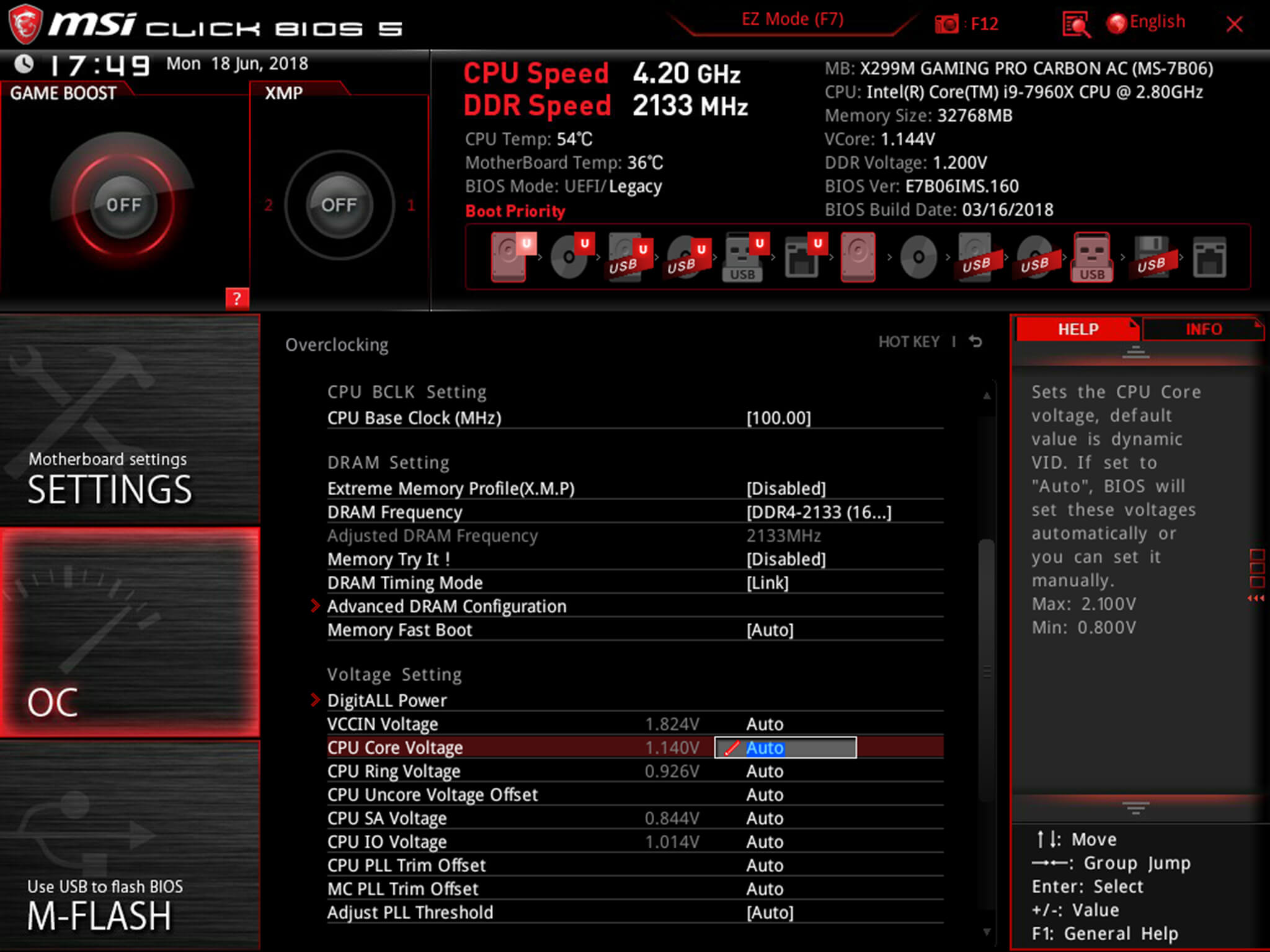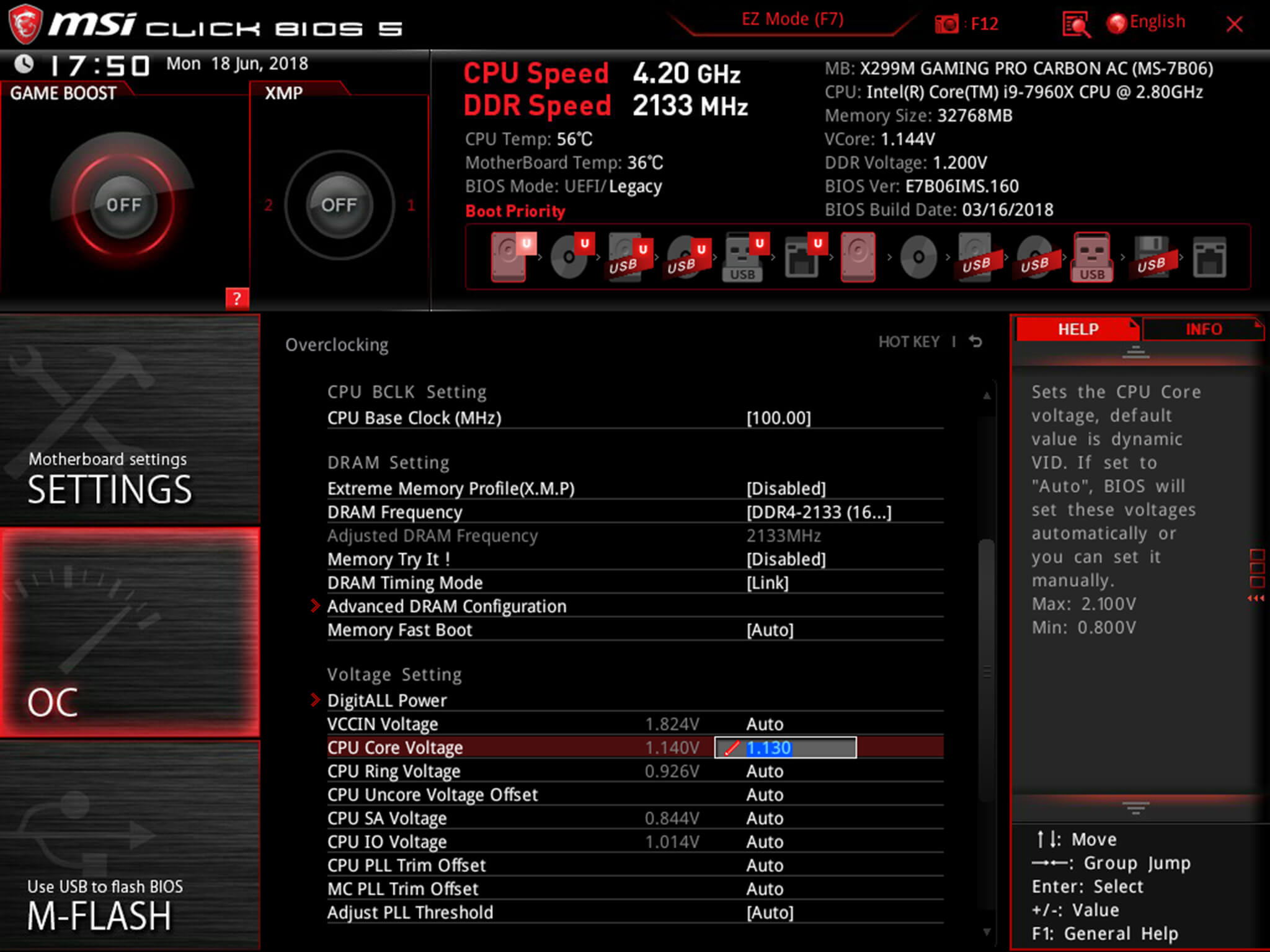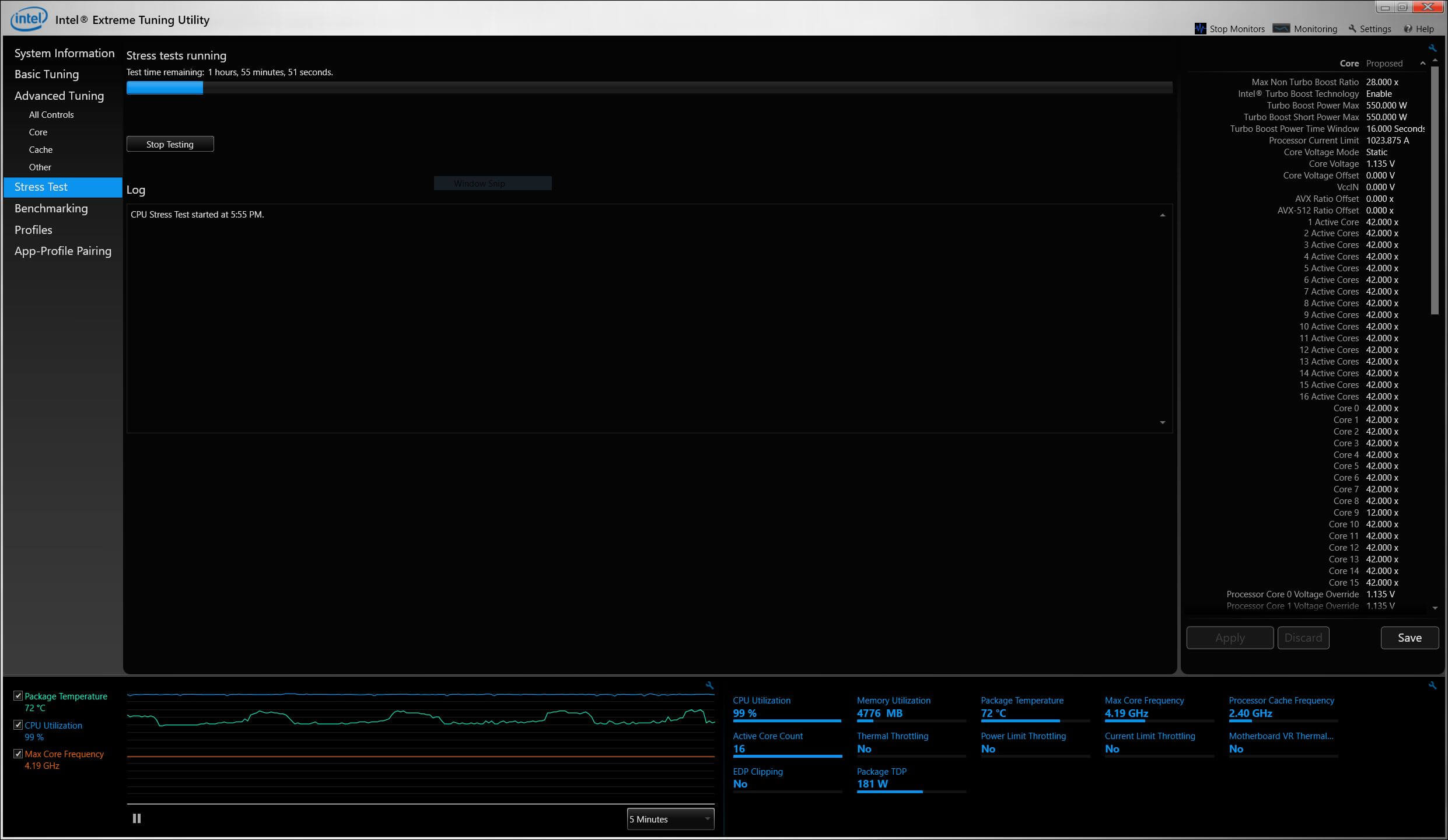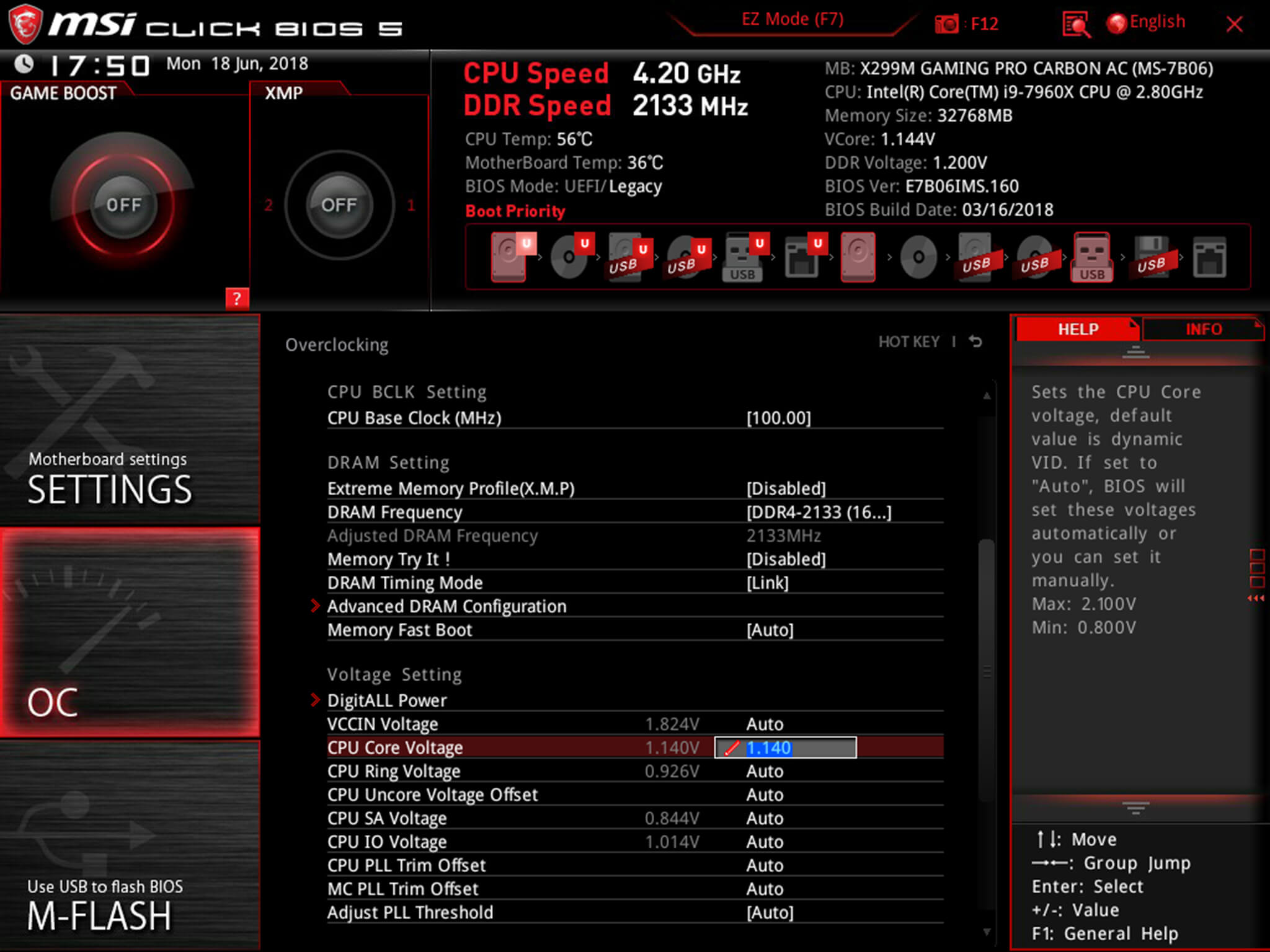The core voltage is different for each processor model, and while all CPUs of the same model have the same VID, not all samples maintain stability at the same clock speeds and Vcore due to slight variations in silicon quality. Every sample of the same CPU model is tested to maintain stability at the default speeds and the VID determined by the manufacturer.
Core voltage typically maintains a constant value while your CPU is in use; however, sometimes under heavy workloads vcore can fluctuate. This is known as Vdroop and can be corrected with load-line calibration. This applies additional voltage as load increases to maintain your CPU's stability.
When it comes to overclocking, you can only push your CPU's frequency so far before your CPU starts to experience instability. Programs might begin to crash or hang up, game performance could suffer or your computer could even fail to boot. This is because your processor isn't getting enough voltage to maintain system stability.
Increasing voltage will allow you to dial in the perfect overclock.
To adjust the voltage, you'll need to boot into your motherboard's BIOS and make adjustments there. The Vcore is expressed as a three decimal value, such as 1.235v. By default, the voltage control is set to auto; this can be overridden by typing in any value. Make sure not to exceed the recommended maximum for your processor.

Before fine-tuning the Vcore, it's important to find a good baseline value for a given speed. This varies from model to model but it can be helpful to read reviews for your CPU, specifically ones that focus on overclocking.
Most publications will list the voltage they required to keep several different speeds stable. Every CPU sample is different and you will need to fine-tune the voltage before calling it done; however, these values do provide a good starting point.

If you boot your machine and don't find any stability issues, then you know it's time to start decreasing the voltage. When overclocking, you want to find the lowest voltage required to maintain stability. More voltage equals more heat and this will allow you to keep temperatures under control.

The safest way to adjust voltage is with increments of .01 volts. Decrease voltage until your computer starts showing signs of instability under load. Use a program like Intel's Extreme Tuning Utility (XTU) or Prime95 to stress test your processor.
If the test fails or crashes, then you need to raise the voltage back up to the previous stable point. For optimal efficiency, you can increase the voltage by .005 instead and again test for stability.

Conversely, if your overclock isn't stable at your baseline voltage, you will then need to increase the voltage until your computer shows no adverse effects and then decrease in increments of .005 to fine tune.

Overclocking is not the only time it can be useful to adjust voltage. As mentioned, higher voltage levels cause your CPU to generate more heat, regardless of frequency. Some CPU samples may have a higher VID than is actually required at the default frequency. Undervolting your processor allows your to maintain stability while decreasing temperatures and extending the life of your processor.
It's a common misconception that disabling Turbo Boost is a more effective substitute for shedding heat. While this does result in decreased temperatures, it is not an alternative as the purpose of undervolting is to maintain the same level of performance while generating less heat. When making adjustments, the same principles apply here as with overclocking, decrease Vcore in increments of .01 and then fine tune with adjustments of .005.
 Best iPad deal: Save $132 on Apple iPad (10th Gen)
Best iPad deal: Save $132 on Apple iPad (10th Gen)
 Adele plays stand
Adele plays stand
 This conspiracy theory about Beyoncé's twins is bonkers so obviously we believe it
This conspiracy theory about Beyoncé's twins is bonkers so obviously we believe it
 People are pissed they didn't get more snow during Blizzard 2017
People are pissed they didn't get more snow during Blizzard 2017
 'The Last of Us' Season 2, episode 3's opening credits has a heartbreaking change
'The Last of Us' Season 2, episode 3's opening credits has a heartbreaking change
 Justin Bieber is sick of overeager fans, and he ain't afraid to say so
Justin Bieber is sick of overeager fans, and he ain't afraid to say so
 This YouTuber is the realest damn thing to happen to 'beauty vlogging'
This YouTuber is the realest damn thing to happen to 'beauty vlogging'
 'Watchmen' Season 1 just ended. Here's what we hope for in Season 2.
'Watchmen' Season 1 just ended. Here's what we hope for in Season 2.
 Vudu offers 'rental redos' in case you hate a movie
Vudu offers 'rental redos' in case you hate a movie
 'Black Mirror' Season 7: 'Hotel Reverie,' explained
'Black Mirror' Season 7: 'Hotel Reverie,' explained
 Gifts to make a 'dumb' car as smart as a Tesla
Gifts to make a 'dumb' car as smart as a Tesla
 'A Berry Royal Christmas' with William and Kate is more than a royal bake
'A Berry Royal Christmas' with William and Kate is more than a royal bake
 The Olympics episode of 'The Office' was inspired by a real office Olympics competition
The Olympics episode of 'The Office' was inspired by a real office Olympics competition
 Apple iPhone 17 Pro leaks highlight major new design change
Apple iPhone 17 Pro leaks highlight major new design change
 The tech that changed us: A decade in review
The tech that changed us: A decade in review
 Look! No hands (or feet) needed to fly this autonomous helicopter.
Look! No hands (or feet) needed to fly this autonomous helicopter.
 Move over Gigi, Tweety the canary is modeling's new fresh face
Move over Gigi, Tweety the canary is modeling's new fresh face
 Best Samsung Frame deal: Free Music Frame with Frame Pro art TV purchase
Best Samsung Frame deal: Free Music Frame with Frame Pro art TV purchase
 Elon Musk said he could fix state energy crisis in 100 days. Here's his chance to prove it.
Elon Musk said he could fix state energy crisis in 100 days. Here's his chance to prove it.
Forget 4G, Indian telecom operators working with Nokia to deploy 5GA eulogy for TV siblings inexplicably cut from classic showsThe Situation from 'Jersey Shore' has new tax evasion problems, could face 20 yearsAnd Peggy: MLB team's sneaky 'Hamilton' joke is a pitchNew Snapchat geofilter to lure teen voters in Scotland'SNL' captures the critical moment before Kendall Jenner's Pepsi ad shoot'Minecraft' Marketplace gives fan creators a way to make moneyHey internet, get ready for another big fight over net neutralityGlobal online game offers clues about why we get languages so very wrongThe internet to United: ReExpedia wants you to step into your hotel rooms with virtual realityHow breast implants nearly derailed a UFC boutKayak At Work tool looks like an Excel doc for SFW travel planningBill Gates, VR super nerd, will now take you into the futureTeen has truly multilayered response to shady nude photo requestJohn Oliver explains why Trump's Syria strike is so dangerousSoftware block appears to brick iPhone 7s with unlicensed serviceBasically every college student has Netflix (but guess how many pay for it)Retro hipster style meets functional design in this oldChina is dominating the world in esports earnings Scientists just expanded the search for rocky alien worlds with air What Are Chiplets and Why They Are So Important for the Future of Processors NYT Strands hints, answers for June 20 How Jenny Solares earned trust in her audience — and a few million followers British and Irish Lions 2025 livestream: How to watch Lions Tour for free How CPUs are Designed and Built, Part 2: CPU Design Process Trinidad and Tobago vs. Haiti 2025 livestream: Watch Concacaf Gold Cup for free Meta Oakley smart glasses debut with 3K video, $499 price tag NYT Connections Sports Edition hints and answers for June 18: Tips to solve Connections #269 Bayern Munich vs. Boca Juniors 2025 livestream: Watch Club World Cup for free NYT Connections hints and answers for June 20: Tips to solve 'Connections' #740. VidCon 2025: Top creators share their success secrets Pornhub is restored in France — for now NYT Strands hints, answers for June 19 Moon phase today explained: What the moon will look like on June 20, 2025 Flamengo vs. Chelsea 2025 livestream: Watch Club World Cup for free Alcaraz vs. Rinderknech 2025 livestream: Watch Queens Tennis for free Episource data breach impacts over five million Americans Display Tech Comparison: IPS vs. VA vs. TN vs. QD VidCon 2025: Hank Green and other creators reflect on YouTube's changes
2.1937s , 10131.75 kb
Copyright © 2025 Powered by 【Squirting Pussy】,Warmth Information Network